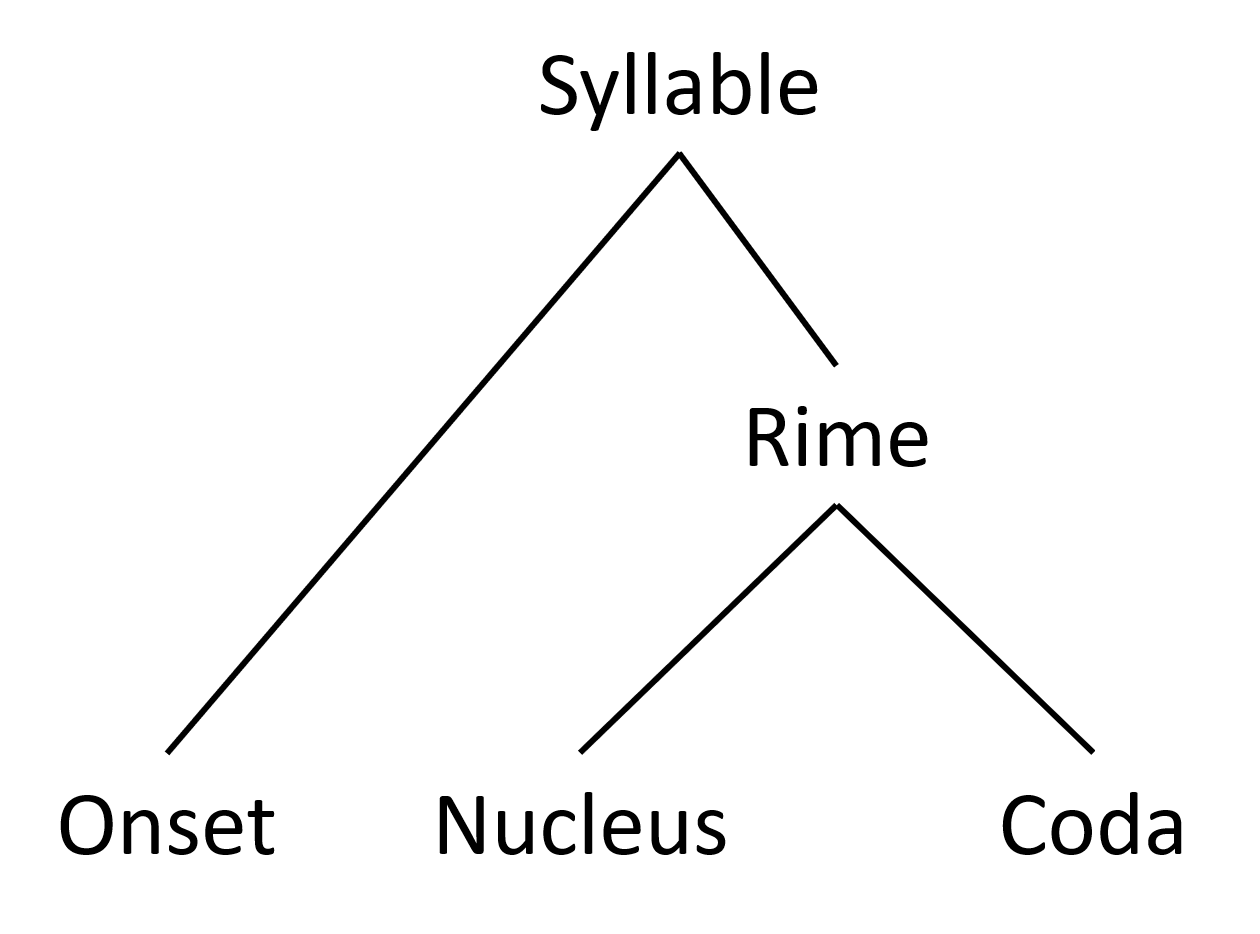2.5 Syllables
Dinesh Ramoo
While phonemes are the smallest units of sound, we don’t actually speak in phonemes. If I say the word ‘cat’ /kæt/ and record it, I won’t be able to break it into three units of /k/, /æ/ and /t/. Therefore, the smallest unit of articulation is not the phoneme but rather the syllable. Most native speakers of a language will know how many syllables are in a word in their language. You can try this in English by saying a word slowly. For example, the word ‘elephant’ has three syllables: e-li-phant. As seen in Figure 2.3, all syllables must have a mandatory nucleus or peak. This is usually a vowel. Some languages can also have a syllabic consonant as a nucleus of a syllable as in the English word ‘button’ [bʌtn̩] where there are two syllables [bʌ] and [tn̩]. You can see that the second syllable has no vowels but a syllabic [n̩] as the nucleus.
Consonants that come before the nucleus of a syllable are know as onsets and those that come after it are called codas. The nucleus and coda of a syllable form a group called a rime. These onsets and codas can be complicated or simple depending on what is allowed in a language. English allows up to three consonants in the onset and at least as much in the coda. Consider the word ‘twelfths’ /twɛlfθs/. It has two consonants in the onset and four consonants in the coda. Generally, the onset is more restricted in what is consonants are allowed.

In English, you can have almost all consonants other than the velar nasal /ŋ/ as an onset. If there are two consonants in the onset and the first one isn’t /s/ then the second has to be either /l/, /r/, /w/, or /j/. if there are three consonants in the onset, then the first has to be an /s/, the second has to be either /p/, /t/ or /k/, and the third has to be either /l/, /r/ or /w/.
Living Language
Consider some words in your language and try to syllabify them. Think of what phonemes occur in the onset, nucleus and coda of these syllables. Can you come up with long onsets and codas in your language? Ask a friend who speaks another language to do the same. Are there any differences between your languages’ syllable structure?
As we saw earlier, what is allowed in the onset, nucleus and coda of a language can be different across languages. While a sequence such as /pl/ is allowed in English, /ps/ would not be allowed. However, /ps/ is a legal sequence in Greek which is why we still spell ‘psychology’ with the ‘ps’ sequence even though English speakers don’t pronounce the ‘p’. Similar examples of Greek onsets include /mn/ as in ‘mnemonic’. Figure 2.4 illustrates the syllable structure of the word Tk’emlúps ‘Kamloops’ in Secwepemc. As we can see, Secwepemc allows the sequence of an unvoiced dental stop and a glottalized velar stop /tkˀ/ in the onset of its syllable. The sequence /ml/ is not a legal onset in Secwepemc, so it gets separated between two syllables, the /m/ becoming the coda of the first syllable and the /l/ becoming the onset of the second.

As syllables are the smallest units of articulation, they provide the rhythmic patterns of a language. In languages such as English, syllables carry features such as stress. This determines which syllable in a word receives emphasis. Try saying ‘I am recording a song.’ You will stress the second syllable in the word ‘recording.’ Now say ‘That was a record.’ You will find yourself placing more stress on the first syllable of the word ‘record.’ Languages that place equal time periods for stressed syllables are called stress-timed languages. English is a stress-timed language and we can see how this is employed in Shakespeare’s sonnets with iambic pentameters. Each line consists of five iambs and each iamb consists of two syllables with the second one more stressed that the first. As we see in Figure 2.5, this creates a beautiful pattern of unstressed and stressed syllables that may even go across word boundaries. Read the sonnet out loud and you will notice the stress patterns.

Unlike English, other languages may produce each syllable with equal time. These are called syllable-timed languages. French is a good example of such a syllable-timed language. Poetry in syllable-timed languages will make less use of stress and will take into account what consonants appear in the coda of the syllable to determine the structure of their poems.
Media Attributions
- Figure 2.3 Syllable Structure by Dinesh Ramoo, the author, is licensed under a CC BY 4.0 licence.
- Figure 2.4 Syllable Structure of the word Tk’emlúps by Dinesh Ramoo, the author is licensed under a CC BY 4.0 licence.
- Figure 2.5 Stress Patterns in a Shakespearian Sonnet contains an edited version of The Droeshout portrait of William Shakespeare, and is a public domain work of art.
The smallest unit of speech.
The part of the syllable that is mandatory and usually includes vowels and sometimes syllabic consonants. Also called the peak.
The part of the syllable that is mandatory and usually includes vowels and sometimes syllabic consonants. Also called the nucleus.
The part of the syllable that includes all the consonants that occur before the nucleus.
The part of the syllable that includes all the consonants that follow the nucleus.
The part of the syllable consisting of the nucleus and coda.

